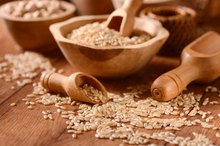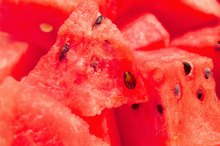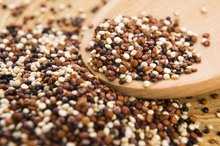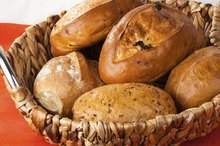Nutrition for Fructose Malabsorption
If you have fructose malabsorption, you need to avoid some healthy fruits as well as some sugars and sweetened processed foods and drinks to avoid suffering from abdominal bloating, pain, flatulence, diarrhea or constipation. Fructose malabsorption is often accompanied by intolerances to some types of short-chain carbohydrates, including polyols, fructans, lactose and galactans, which can further restrict your food choices. Whether you have only fructose malabsorption or malabsorb all types of short-chain carbohydrates, you can get all the nutrition you need to stay healthy while controlling your symptoms.
Fruits
To prevent the uncomfortable side effects of eating fructose if you have fructose malabsorption, stay away from pears, apples, cherries, mangoes and all types of dried fruits and fruit juices. Some fruits, such as watermelon, blackberries, peaches, nectarines, apricots and lychees, have a low fructose content but contain other short-chain carbohydrates that are problematic for some people with fructose malabsorption. Stick with blueberries, strawberries, tangelo, oranges, grapefruit, banana and kiwifruit to get the healthy nutrients found in fruits without side effects.
Vegetables
Brown Rice on a Low-Fructose Diet
Learn More
A few vegetables contain higher fructose levels, including asparagus, artichoke and sugar snap peas. Fructan-containing vegetables, such as onion, garlic, cabbage, broccoli and Brussels sprouts, as well as polyol-containing vegetables, such as cauliflower, mushroom and avocado, may also pose digestive problems in sensitive people. You can obtain the fiber and nutrients your body needs from lettuce, green beans, carrots, bean sprouts, cucumber, zucchini and winter squashes.
Protein and Fat
Foods that are rich in protein and fat are safe for people with fructose malabsorption because they do not contain short-chain carbohydrates, unless sugar, wheat, fresh onion or onion powder on other problematic ingredients are added in their processing. Stick to plain chicken, turkey, fish, seafood, pork, beef and eggs. Prepare and cook them yourself with the ingredients you tolerate. You can also get healthy fats from olive oil, coconut oil and butter. You can experiment with different types of unseasoned nut and natural nut butters, such as macadamia, walnuts and natural almond butter, as tolerance varies between individuals.
Grains and Legumes
Sorbitol & Fructose
Learn More
Avoid grain products processed with high-fructose fruits or high-fructose sweeteners, which include high-fructose corn syrup and honey. Wheat and rye are also rich sources of fructans, while legumes, including beans and lentils, contain galactans. Some people with fructose malabsorption can tolerate fructans and galactans, but not everyone can. You can experiment with small amounts to see whether these foods trigger your symptoms. Replace these foods with safer grains, such as quinoa, oat flakes, rice and buckwheat and tubers, such as sweet potatoes and potatoes. These foods can provide you with the carbohydrates, fiber and other nutritious compounds your body requires.
Related Articles
References
- "Journal of Gastroenterology & Hepatology"; Evidence-Based Dietary Management of Functional Gastrointestinal Symptoms: The FODMAP Approach; P.R. Gibson; October 2009
- "The Low FODMAP Diet -- Reducing Poorly Absorbed Sugars to Control Gastrointestinal Symptoms"; Eastern Health Clinical School -- Monash University; 2011
- "IBS -- Free at Last!"; Patsy Catsos; 2009
Writer Bio
Aglaee Jacob is a registered dietitian. She has experience working with people who have diabetes, cardiovascular disease, hypertension and obesity issues. Jacob obtained a bachelor of science and a master of science, both in nutrition, from Laval University in Quebec City, Canada.









